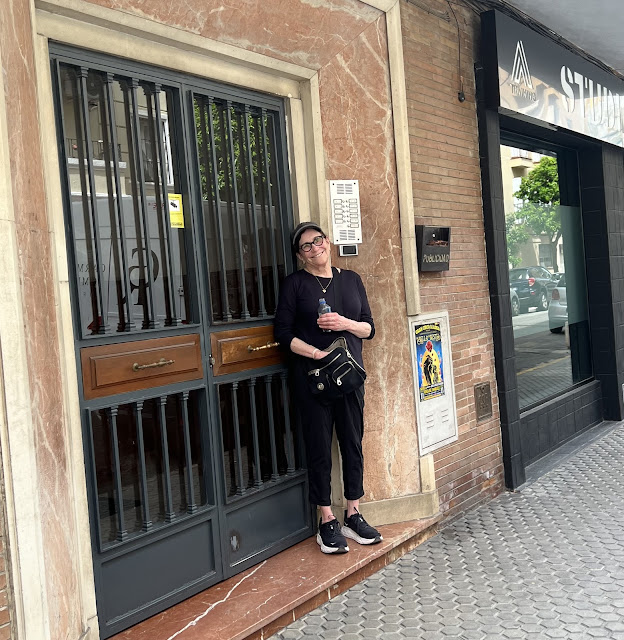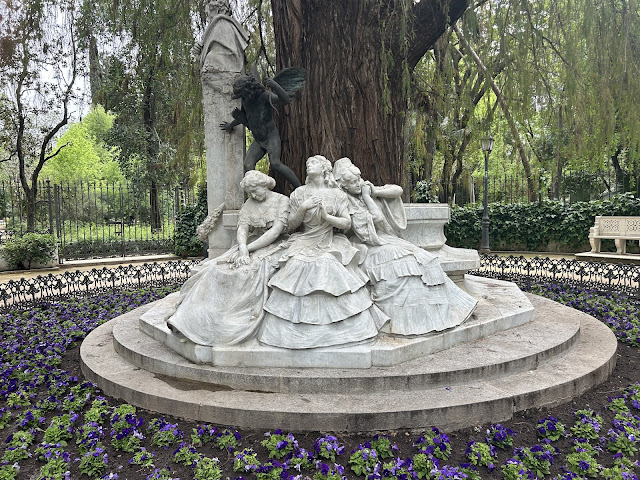Sandra Moreano's Blog
Wednesday, June 25, 2025
Tuesday, May 6, 2025
Cyanotype Workshop Primer
Test your knowledge on Cyanotypes
How does a treated paper turn blue under the sun?
What are the colors of the rainbow?
Red, Orange, Yellow, Green, Blue, Indigo and Violet.
Can sunlight split the colors of the rainbow?
Yes, If we take a ray of light and look at it through a prism, we can see sunlight split into the colors of the rainbow. Each colored light wave has a distinct frequency.
But if we were birds, we could see one more color. And although that color is invisible to people, birds can see it. It is makes our skin darken and causes a reaction to certain chemicals.
Does anyone know the name of this color?
This color is called ultraviolet light. Invisible to humans but visible to some animals.
Have you heard of the Electromagnetic Spectrum?
The electromagnetic spectrum shows a range of waves at different frequencies, all of which are different forms of energy. In addition to visible light, the spectrum includes many other wavelengths—such as radio waves, X-rays, microwaves, infrared, and ultraviolet—each with its own specific uses.
How many years ago was this spectrum discovered?
IN 1820 by Christian Ørsted
Who invented the was Blueprint process that uses two chemicals and UV light?
Using Ultraviolet light to create a cyanotype was invented by 1842 by William Herschel. Even though we humans can't see this light, it can interact and alter matter. Two simple chemicals that when combined together and react to ultraviolet light turn the paper dark blue. During the workshop we are going to use these chemicals to explore making silhouettes imprints on paper.
What can you do with cyanotypes?
1) Architects drew on glass or vellum to keep parts of the paper from exposure The lines they drew became the white parts. The results are called blueprints. With this method they could make many copies at a time. Before this invention each diagram had to be redrawn one at a time. ( Today we use digital technology to do the same thing.)
2) Botanists like Anna Atkins, made a book from plant silhouettes created with cyanotype in 1843. Today we use this form to make art and record the natural world.
3) Photo negatives are used today to make prints as well. Negatives are laid over the treated paper and exposed to the sunlight.
How do you make a print?
For class, will be using a special paper coated with a substance that is sensitive to UV light. We will cover parts of the paper with plants and objects to prevent exposure in those areas. The paper will be kept hidden from light until we are ready to expose it.
To expose the paper, put it the sunlight for about 15 minutes. Afterwards the plant matter and objects are removed and the paper will be rinsed free of the chemicals.
Below are a few samples.
Thursday, May 1, 2025
The Prado
I could have come here every day for a month. We saw very little. But it was magnificent. No photos allowed, but I did find these images on the Prado website.
"Las Meninas," meaning "The Maids of Honor," A 1656 painting by Diego Velázquez
"Blind Man's Bluff," a 1787 painting by Francisco de Goya
Created as a plan for weaving a Tapestry.
"The Third of May 1808" is a painting by the Spanish artist Francisco Goya
"Christ falls on the way to Calvary #1" is a 1515 painting by Raphael.
“Portrait of Isabella of Portugal” in 1548 by Titian
This rivals the Mona Lisa. Titian was a discovery for me that day
"The Haywain Triptych," a 1515 painting by Hieronymus Bosch.
Sevilla
This garden sculpture is an ode to the poem Glorieta by Gustave de Becquer. The poet addresses three kinds of women's faces. First is the face that dreams of love. The second is the face that finds love, and the third is the face that is lost to love.
Wednesday, April 30, 2025
The Reina Sofia
In 1969, this massive building was transformed from a hospital to a Museum of Modern Art. The Hallways are massive, and I could immediately imagine the gurneys going up and down the corridors, which all looked out onto an outdoor courtyard.
Tuesday, April 29, 2025
The Unspeakable Beauty of Toledo
I hesitate to write about Toledo. The town has maintained its medieval presence. And so it was easy to get lost in the past. It seems to me that spirituality, religions, and science were blended together. Technological advances were slower. And there was no separation between spirituality and religion. There was religious tolerance for a while , but the Spanish Inquisition put an end to that. I came away with dozens more questions than answers. And I am not sure how to get them answered.
Here are a few
1) Do societies that embrace free speech foster science? Is this what progressive means?
2) In Toledo, what did the Christians, Jews, and Muslims contribute to astronomy? Or construction?
3) Was there a stronger Roman influence in France than Spain due to its proximity? And did that make for better roads, aqueducts and agriculture and medicine?
4) How were ideas exchanged from town to town?
5) What role did beauty play in the construction? Were they said to be inspired by GOD? What was life like when everyone embraced the idea of a soul and Father? How did it elevate its people, and how did it divide them?
I think I need to research and get back to this. It's all basic history. Now that I have seen the place, my interest is peaked.


















































